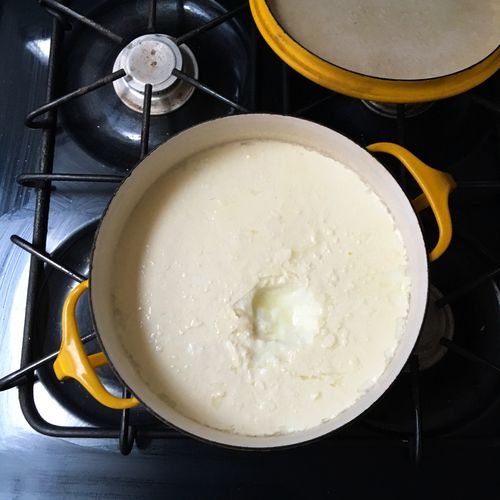Popular on Food52
Continue After Advertisement
76 Comments
Neva M.
January 4, 2019
I have been making nonfat yogurt for at least 20 years, usining nonfat dried milk. tangy and easy...6 hours perfect..no milk fat or sugar!!!
vs317
May 10, 2018
Tried this and could not get the yogurt to set. I guess my oven light produces less heat than other people's or something. That method wasn't close to warm enough for me. Going to try it again with the "keep warm" function. If that doesn't work, I'll explore some of the great-sounding recipes here in the comments.
Neva M.
January 4, 2019
try turning on to 150-200. then turn off when you put the yogurt in. do not open..until time is up..put a sticky on the door...to remind you not to turn on the oven or open the door!
Pamela G.
April 30, 2018
I heat the milk to a boil, shut it off and let it cool down to 110 degrees. I then pour it into a clean mixing bowl and whisk in the starter. Then it goes into warmed Corning Ware casserole dishes with the lids on. I place the casseroles on a heating pad turned on warm, throw several old bath towels over the set up and let 'er rip for however long I want. I sometimes leave it go 12 to 24 hours. Then I set the casseroles in the fridge until it is cold, whisk it and pour the yogurt into containers for later consumption. Works great.
witloof
March 25, 2018
Agree with the author about not using powdered milk, mostly because it tastes awful.
Emily R.
March 7, 2018
I prefer yogurt for probiotics and greek yogurt full of probiotics.
I have blog on Probiotics and yogurt, you can read all the information.
thanks
I have blog on Probiotics and yogurt, you can read all the information.
thanks
Louise
March 5, 2018
I've started making my yogurt for the past 6 months and recently have had a string of batches that taste carbonated. Not sure what is causing it. I have noticed it's usually when I've used a culture from previous batch, though the batch was not fizzy. How do I fix this? Don't want to have to keep buying new cultures!
Pamela G.
April 30, 2018
I have found if you use starter from a previous batch it doesn't work as well. By the 3rd time around you get really scuzzy results. I always use fresh, plain store yogurt. Works much better.
Jenna
December 28, 2021
I always freeze my starter in a small Mason jar right after making a fresh batch as I'm not always consistent in making more yogurt every few days. I bring it out to thaw as I'm warming and cooling milk for a new yogurt batch. I've never had a bad batch using this method and at times I've used starter that has been frozen for a couple months.
Bob R.
January 25, 2018
I just made a batch of yogurt using Ultra Pasteurized Half and Half milk, it came out indescribably thick and delicious. Fermented for 10 hours; it was medium tart. If you make yogurt, you have to try a batch with half and half !!
Robbie L.
January 11, 2018
My latest method was gleaned from other websites. I slowly heat a half gallon of whole milk in a stainless pan (rinsed with cold water before pouring in the milk) to 180, checking with my instant read thermometer. Cool to 105-110 (takes about 45 minutes; I set my timer). Then I whisk 1/2 cup of room-temperature yogurt reserved from my previous batch with 1/2 cup of the warm milk and gently stir into the pan of milk. Using a canning funnel, I ladle the milk into 2 sterilized Ball jars, plus 1 sterilized 1/2 pint jar (this is part of my starter for the next batch), and screw on plastic lids. Last of all, I put all 3 jars in a very small cooler and add the hottest my tap water can get to the entire cooler until the water reaches halfway up the quart jars. (I do have to set the half pint jar on top of a small upside-down bowl so it doesn't float away!) If I do this after dinner, the yogurt will be well set and taste delicious by breakfast the next day. It's been a foolproof method for me, and I've tried many methods over the last 45 years!
Margaret K.
January 5, 2018
Using sterile utensils is to avoid cross-contamination by other molds that might be hanging around your kitchen (cheeses, fruit, vinegars, etc.) that could interfere with proper yog'ing. Heating to 180 degrees is not to further sterilize pasteurized milk, it is to make the proteins coagulate better. You need to heat to 180 even if you're using reconstituted powdered milk.
E M.
January 5, 2018
"since most milk sold commercially is already pasteurized, you likely don’t have to worry about any bacteria...get the vessels you’re planning on storing the yogurt in very clean by washing in hot, soapy water or running through the dishwasher...Line a colander with a very, very clean dishtowel..."
All this emphasis on cleanliness is great from a food safety standpoint, but then you illustrate the article with a picture of someone's finger in the starter.
That is really not a good sanitary practice.
All this emphasis on cleanliness is great from a food safety standpoint, but then you illustrate the article with a picture of someone's finger in the starter.
That is really not a good sanitary practice.
Marianne B.
November 29, 2017
The BEST thing to do with whey? ! ! Use it for starter. It has all the bacteria your yogurt has. Works like a charm.
Merrick M.
November 29, 2017
This is a great way of making yogurt when you have the time. For all the other times try the EZYogurtMaker dot com to prep up to 32 servings with only 1 minute of your time. Best invention ever. Saves us time and money and no more washing dishes/pots/individual containers...
Ann
October 17, 2017
Over 160 degrees for more than a few minutes (doesn't need to boil, but does need to stay above temperature for more than an instant). Cool to at least 110. Add starter, and put in Instant Pot or "proof" setting of oven at 90 degrees.
betsy
September 15, 2017
can someone help me? I put my yogurt and milk in the yogurt machine and forgot to turn machine on. It sat in there for 12 hours. Should I throw away or can I use it
Andie P.
September 15, 2017
It should be okay. Just turn the machine on and let it go for another 12 hours. Because it has been so warm here for the past few weeks, I have just left the milk with the culture on the kitchen counter and it has progressed just fine. You can tell at the end of the process - if the milk is thick, it has converted. Did you heat it to 180° and then cool it to 115° before adding your yogurt culture? That is always necessary for the milk to "convert" the beneficial bacteria.
Andie P.
August 24, 2017
I have posted several times in the past. I have an entire treatise about yogurt on my blog. NEVER BOIL THE MILK! Bring the temp up to 180-200 degrees (186 is optimal) then cool to 115°F. and then add the powdered cultures or the culture from a previous batch. There are certain ways to manipulate the yogurt. Less butterfat means IT WILL HAVE MOR OF A "TANGY" FLAVOR. More butterfat with produce a thicker yogurt and LESS TANG! You can use half and half and even heavy cream, which gives a product that when strained - produces very little whey - that is a good substitute for clotted cream, without all the work. I make kefir, does not require heating. I make sour cream and creme fraiche and cream cheese with CULTURES from the New England Cheesemaking company. I use probe thermometers that are sterilized and you need the temperature deep in the liquid. An infrared thermometer reads ONLY THE SURFACE temp and is not accurate.
Scribbles
February 4, 2018
Totally agree Andie! And, a quick way to cool down the milk is to set the pot in a sink of cool water - again watching the thermometer till it reaches 115. I make yogurt every week and it always turns our perfect with Andie's method - I have used all milk, part half and half and even part whole cream - it's all good.
Marianne B.
August 24, 2017
oops! For my last note - use the yogurt in place of sour cream to make sour cream cake. Sorry.
Marianne B.
August 24, 2017
I love my mother in laws sour cream cake. I use my yogurt instead of cream cheese - there is NO difference.
Marianne B.
August 24, 2017
One helper: use whey as starter for next batch. It has the same bacteria as the yogurt. Another helper, strain yogurt for up to 20hours..what you get is yogurt CREAM CHEESE!
Damian
July 4, 2017
If you have a good thermometer gun (this prevents introducing non-culture bacteria into the mix), you can measure and document the differences in how your yogurt is prepared and establish an optimal recipe for the kind of yogurt that you find most appealing. The documentation is important as in ever kind of research. Make it a sort of good tasting introduction to real science for your children.










Join The Conversation